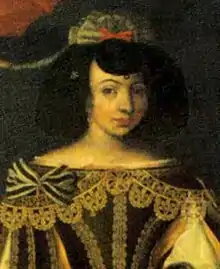Joana, Princess of Beira
Joana, Princess of Beira (18 September 1635 – 17 November 1653; Portuguese pronunciation: [ʒuˈɐnɐ]; English: Joan) was a Portuguese infanta (princess), and the eldest surviving daughter of John IV, King of Portugal (the first of the House of Braganza) and his wife Luisa de Guzmán.[1]
| Joana | |
|---|---|
| Princess of Beira | |
 | |
| Born | 18 September 1635 Ducal Palace of Vila Viçosa, Vila Viçosa, Portugal |
| Died | 17 November 1653 (aged 18) Ribeira Palace, Lisbon, Portugal |
| Burial | |
| House | Braganza |
| Father | John IV of Portugal |
| Mother | Luisa de Guzmán |
| Religion | Roman Catholicism |
Life
Joana was born in Vila Viçosa on 18 September 1635. Her father created her Princess of Beira, a title subsequently used by the eldest daughter of the monarch. She died unmarried in Lisbon at the age of 18 on 17 November 1653.[2] She was first buried at the Jerónimos Monastery and then moved to the Monastery of São Vicente de Fora.
Ancestry
| Ancestors of Joana, Princess of Beira | |||||||||||||||||||||||||||||||||||||||||||||||||||||||||||||||||||||||||||||||||||||||||||||||||||||||||||||||||||||||||||||||||||||||||||||||||||||||||||||||||||||||||||||||||||||||||||||||||||||||||||||||||||||||||||||||||||||||||||||||||||||||||||||||||||||||||||||||||||||||||
|---|---|---|---|---|---|---|---|---|---|---|---|---|---|---|---|---|---|---|---|---|---|---|---|---|---|---|---|---|---|---|---|---|---|---|---|---|---|---|---|---|---|---|---|---|---|---|---|---|---|---|---|---|---|---|---|---|---|---|---|---|---|---|---|---|---|---|---|---|---|---|---|---|---|---|---|---|---|---|---|---|---|---|---|---|---|---|---|---|---|---|---|---|---|---|---|---|---|---|---|---|---|---|---|---|---|---|---|---|---|---|---|---|---|---|---|---|---|---|---|---|---|---|---|---|---|---|---|---|---|---|---|---|---|---|---|---|---|---|---|---|---|---|---|---|---|---|---|---|---|---|---|---|---|---|---|---|---|---|---|---|---|---|---|---|---|---|---|---|---|---|---|---|---|---|---|---|---|---|---|---|---|---|---|---|---|---|---|---|---|---|---|---|---|---|---|---|---|---|---|---|---|---|---|---|---|---|---|---|---|---|---|---|---|---|---|---|---|---|---|---|---|---|---|---|---|---|---|---|---|---|---|---|---|---|---|---|---|---|---|---|---|---|---|---|---|---|---|---|---|---|---|---|---|---|---|---|---|---|---|---|---|---|---|---|---|---|---|---|---|---|---|---|---|---|---|---|---|---|---|---|---|
| |||||||||||||||||||||||||||||||||||||||||||||||||||||||||||||||||||||||||||||||||||||||||||||||||||||||||||||||||||||||||||||||||||||||||||||||||||||||||||||||||||||||||||||||||||||||||||||||||||||||||||||||||||||||||||||||||||||||||||||||||||||||||||||||||||||||||||||||||||||||||
References
- Mendes 2020, p. 194.
- Newitt 2019, p. 84.
Sources
- Mendes, Paula Almeida (2020). "The exaltation of the "holines" of the Braganca dynasty as a legitimating strategy in the seventeenth century". In Rodrigues, Ana Maria S. A.; Silva, Manuela Santos; Spangler, Jonathan (eds.). Dynastic change : legitimacy and gender in medieval and early modern monarchy. Routledge.
- Newitt, Malyn (2019). The Braganzas: The Rise and Fall of the Ruling Dynasties of Portugal and Brazil, 1640-1910. Reaktion Books.
This article is issued from Wikipedia. The text is licensed under Creative Commons - Attribution - Sharealike. Additional terms may apply for the media files.
